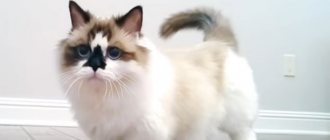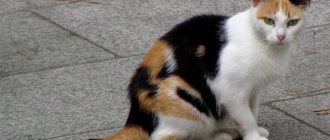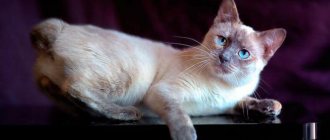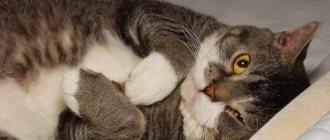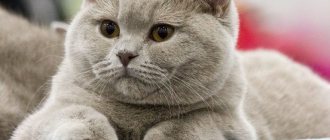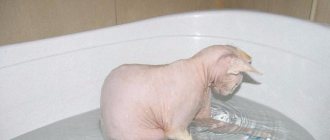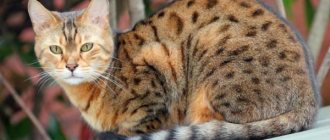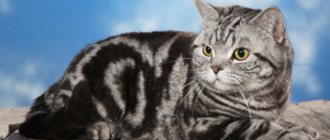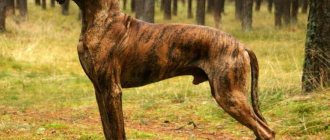Origin of the breed
Havana is a breed obtained by breeding Oriental cats. The unique cats have nothing to do with the island of Cuba; the breed appeared in the UK.
In the 19th century, unusual brown cats were brought to England from Thailand. The British enthusiastically accepted animals with the original “chocolate” color.
In Europe, Thai cats began to symbolize respectability and success. At English exhibitions, Oriental pets invariably attracted attention. In 1888, a representative of the breed even became the winner of one of the exhibitions.
Interesting! The Thai cat received the name Havana due to its original color. Its fur is the color of the tobacco in a Havana cigar.
During World War II, the population of unique cats almost disappeared. The British began to restore the breed. Since there are almost no purebred individuals left, breeders had to dilute the breed with a black European shorthair cat.
The crossing turned out to be successful. The cats received not only an attractive appearance, but also the endurance and strength of the European breed.
Some of the bred cats were sent to the USA, where breeding continued. The Americans took the matter seriously and did not dilute the breed with other species. As a result, the breed standard for the purebred Havana was established in the United States in 1958.
Caribbean name and English origin
The name may be misleading since you are originally from England and not the Caribbean island of Cuba. It was named the Havanese cat because its color resembles Havana cigarettes.
Not only does tobacco resemble the brown fur of this kitten, it also resembles chocolate and coffee. In any case, we are dealing with a very beautiful animal, which comes from a cross bred by English breeders in the middle of the last century.
For breeding Havana cats there were Siamese cats with Chocolate Point and Seal Point, European Shorthair and Russian Blue crossed. the breed was soon recognized in Great Britain and carried across the Atlantic to be introduced to the United States.
Read on:
shorthair cat breeds
There are currently different Breed Standards for the Havana cat in the UK and North America. the former tend towards the more eastern aspect of this kitten, while the latter prefer traits that are closer to the Russian Blue.
We introduce you to the Havanese cat in this post. A cat that is distinguished mainly by its color is because it remembers chocolate, tobacco or coffee, but also remembers curiosity, intelligence and playfulness.
Description of the breed standard
Havana is a medium-sized breed. Females are lighter than males, the former weigh 3–4 kg, the latter – 4–5 kg. Despite its graceful physique, the cat’s weight is quite large, which is due to its strong skeleton and developed muscles.
The Havana cat breed standard is shown in the table.
| head | elongated, narrow, high cheekbones, with an arched profile and a large chin, the angle between the forehead and nose is not pronounced |
| eyes | large, almond-shaped, slightly slanted, the color of the iris is all shades of green |
| ears | large, spaced far apart, with a wide base and sharp ends, slightly inclined forward |
| torso | elongated, lean, sinewy, dignified, harmoniously built, with a tucked belly and narrow chest |
| limbs | long, dry, the hind legs are slightly longer than the front ones, the paws are small, oval |
| tail | long, thin along the entire length, whip-like |
| wool | short, velvety to the touch, shiny |
Colors
Havana cats come in two types of color:
- Havana Brown - red-brown, a mixture of chocolate and mahogany color;
- Havana lilac is a warm pinkish-gray color.
Vibrissae are colored in the same way as wool. The nose and paw pads are pinkish-brown. Spots and patterns on the body are unacceptable.
Interesting! Many Havanese kittens are born spotted. But the spots disappear when the cubs reach one year of age.
Appearance of a Havana cat
In addition to the typical chocolate color, no other color is allowed in this cat's breed standard. other features of Havana Cat are:
- body: muscular and agile.
- size: medium.
- weight: from 2.5 to 5 kg; hangovers are bigger than cats.
- head: longer than wide (wedge-shaped) with a powerful and fairly wide jaw.
- eyes: oval and widely spaced in green color and with a smart and mischievous appearance.
- ears: large, wide neck and triangular in shape, rounded at the top. they stand upright, widely spaced and slightly tilted forward, appearing very alert. The inside of the ears is pink.
- nose sponge: short and angled.
- Neck: Muscular, long and cylindrical.
- legs: strong and straight. The hind legs are longer than the front ones.
- tail: long and thinner towards the tip.
- fur: short and dense, with a mahogany sheen.
Character and temperament
Havana is an active, intellectually developed cat. She does not tolerate loneliness and lack of attention from her master; she is interested in everything that family members do.
Havana is playful, inquisitive, willingly interacts with children and strangers, and participates in children's games and amusements. Therefore, it is recommended to have a pet for large and friendly families who spend a lot of time at home.
A person who rarely appears at home should not get a cat. The animal suffers from loneliness, begins to rage, turn everything upside down, tear up furniture and curtains. An option to solve the problem is to get a second cat of the same breed, then the pets will not be bored without communication.
The Havana cat is talkative and accompanies its every action with a purr. Loves to communicate with the owner and be caressed. Havana is intellectually developed, without any problems he gets used to the tray, scratching post, and rules of behavior in the house. It is not difficult to accustom her to a leash so that she can be taken for a walk.
Oriental cats are jealous, strive to show off in front of the owner, to lead over other domestic animals. If there is a Havana in the house, then you should not buy a puppy: the pet will not get along with it.
Character and behavior of Havana cats: advantages and disadvantages
According to breeders, cats of this breed have their own pros and cons in their character.
Description of behavior typical of Havana cats
Bombay cat - description of Bombay cats
Havana cats are the living embodiment of a perpetual motion machine. Their character is friendly, they are natural friends of man. They love to “chat” with their owner so much that even between communication and food, they will choose the former.
Important! A kitten of this breed will immediately show its intelligence and curiosity. These pets have one amazing habit - they look into their owner's eyes. They are not afraid of being looked at and love to be around.
They use their paws like people use their hands. They can pet their owner in moments of tenderness. They hold food in front of them, like squirrels. The pet hates closed doors, so if the owner goes to the bathroom, he should prepare for the fact that a dissatisfied “meow” will be heard from behind the door.
There is no nastiness in the nature of these cats, they are not harmful and are absolutely not touchy. These beauties don't like to be left alone.
Relationships in the family: to children, to other pets
Havana children are loved beyond measure. They have genuine interest and immense love for children. If the baby does not calculate the force and hurts the cat, the animal will not react with aggression and release its claws, but will prefer to go to another room.
Pets love company very much, so you can safely get another Havana or dog. They get along well with dogs and over time you can observe their tender feelings for each other.
Training and education
The gavan's intelligence allows them to easily learn simple commands. It cannot be said that the animal will understand the words “you can’t”; rather, it will react to intonation.
Amenable to education. She will never allow herself to do too much, even though she is still a fidget. The cat litter box is not a problem for them, but a completely normal part of life.
Havana cat health
Health and disease prevention
The Havana cat has a strong body; with proper care, illnesses rarely occur. Pets live up to 15 years.
From its Siamese ancestors, the Havana Brown received a tendency to several hereditary pathologies:
- cardiomyopathy;
- impaired renal function, urolithiasis (in old age);
- disruption of the functional state of the pulmonary system;
- ulcerative and inflammatory pathologies of the oral mucosa.
Havana is vaccinated annually against calcivirosis, rhinotracheitis, panleukopenia, and rabies. At the time prescribed by the veterinarian, the animal is given drugs to treat helminths.
Care instructions
The Oriental breed does not have an undercoat, so grooming is not difficult. Brush the coat once a week. Bathe your pet infrequently, only when the coat becomes dirty. Use universal zoo shampoo or baby soap. After bathing, dry the body with a towel; do not use a hairdryer, otherwise the delicate coat will dry out.
Eye tears are wiped every day with a napkin moistened with boiled water. The ears are cleaned once every 2 weeks with a cotton swab soaked in veterinary lotion. Teeth are brushed once a week with veterinary paste. As they grow, the claws are shortened with a nail clipper if the cat is not accustomed to a scratching post from an early age.
Important! The kitten is fed 5 times a day; as it grows, the daily number of servings is reduced. After reaching one year of age, the kitten should eat 2 times a day.
The Havana diet is standard, balanced, including vitamin supplements. Representatives of the breed are not capricious in their diet. You can feed your cat both store-bought super premium food and natural food. In the first case, the animal is given not only dry, but also wet canned food. In the second case, the share of meat food in the diet should be at least 70%.
History of the breed
Initially, representatives of the breed - green-eyed cats with chocolate-brown markings - were classified as a variety of Oriental cats.
When in the 20th century it became common to consider only cats with blue eyes to be purebred Orientals, green-eyed kittens turned into mongrels.
Only 50 years later in Great Britain work began on the systematic breeding of chocolate-colored cats, and the Havana became an independent breed only in the 1960s.
According to one version, the breed owes its name to dark brown Cuban Havana cigars. According to another, the name is borrowed from a breed of brown rabbits.
